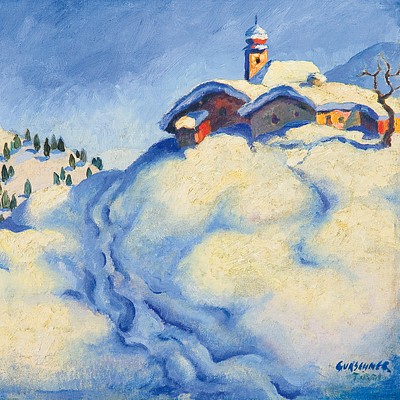TRUDE FLEISCHMANN* (Vienna 1895 - 1990 Brewster, New York)
Lot 37
Estimate:
EUR€6,000 - EUR€12,000
$6,250 - $12,500
Absentee vs Live bid
Two ways to bid:
- Leave a max absentee bid and the platform will bid on your behalf up to your maximum bid during the live auction.
- Bid live during the auction and your bids will be submitted real-time to the auctioneer.
Bid Increments
| Price | Bid Increment |
|---|---|
| EUR€0 | EUR€10 |
| EUR€100 | EUR€50 |
| EUR€700 | EUR€100 |
| EUR€1,000 | EUR€200 |
| EUR€3,000 | EUR€300 |
| EUR€3,600 | EUR€400 |
| EUR€4,000 | EUR€500 |
| EUR€7,000 | EUR€1,000 |
| EUR€16,000 | EUR€2,000 |
| EUR€30,000 | EUR€3,000 |
| EUR€36,000 | EUR€4,000 |
| EUR€40,000 | EUR€5,000 |
| EUR€150,000 | EUR€10,000 |
About Auction
By Widder Auctions
Nov 23, 2023
Set Reminder
2023-11-23 11:00:00
2023-11-23 11:00:00
America/New_York
Bidsquare
Bidsquare : Masterpieces
https://www.bidsquare.com/auctions/widder-auctions/masterpieces-14076
Masterpieces by Austrian and German artists are coming up for auction in Vienna on November 23rd Widder Auctions office@widderauktionen.com
Masterpieces by Austrian and German artists are coming up for auction in Vienna on November 23rd Widder Auctions office@widderauktionen.com
- Lot Description
TRUDE FLEISCHMANN* (Vienna 1895 - 1990 Brewster, New York)
Portrait Altenberg
vintage matt-albumen-print/studio cardboard, 21,2 x 16,6 cm
signed H. Schieberth
(Fleischmann had her professional training 1916 - 1919 at the photo studio of Hermann Schieberth)
handwritten dedication by Peter Altenberg: To my saintly friend and care taker Johanna Staude, october, novembre, decembre 1918. Peter Altenberg, in one of my sinister crisis
verso inscribed In memory of the long night on 3. XII. 1918
depicted in catalogue Trude Fleischmann 2011, p. 15
ESTIMATE °€ 6000 - 12000
STARTING PRICE °€ 6000
The Austrian-American photographer Trude Fleischmann From 1913 to 1916 she completed training at the Graphic Training and Research Institute in Vienna. After a short internship with Madame d'Ora, she completed her professional training in Hermann Schieberth's studio from 1916 to 1919. In 1920 she opened her own studio. There she took photographs of numerous well-known personalities from society, art and culture, including Peter Altenberg, Gustinus Ambrosi, Alban Berg, Wilhelm Furtwängler, Karl Kraus, Hedy Lamarr, Adolf Loos, Tilly Losch, Alfred Polgar, Max Reinhardt, Thimig, Hilde Wagener , Bruno Walter, Paula Wessely, Grete Wiesenthal and Stefan Zweig. Dance and nude recordings were also made. The nude photographs of the dancer Claire Bauroff became famous. Fleischmann's photographs were printed in all common magazines: Berliner Illustrirte Zeitung, Die Bühne, Die Dame, Moderne Welt, Wiener Bilder, Wiener Magazin, Wiener Mode. After the annexation, Fleischmann managed to escape via Paris and London to New York in 1938 with the help of the photographer Marion Post Wolcott, with whose sister Helen she had studied in Vienna. In 1940 she opened a photography studio in Manhattan. In NY she photographed well-known artists and intellectuals, including Richard Coudenhove-Kalergi, Albert Einstein, Otto von Habsburg, Oskar Kokoschka, Lotte Lehmann and Arturo Toscanini. In 1969 Fleischmann retired from professional life and moved to Lugano. In 1988 she returned to the USA. Many photographs are in renowned collections: MoMA, New York Public Library, Leo Baeck Institute, Getty Museum in L.A. Vienna Museum, the Theatermuseum Vienna and the Photographis Collection of Bank Austria. Peter Altenberg (actually Richard Engländer) attended the Akademisches Gymnasium in Vienna and then attended legal and medical lectures at the university. He became a legendary figure through his eccentric lifestyle and as a constant guest at renowned coffee houses (Central, Herrenhof). From 1892 he wrote down his observations, ideas and criticisms, and in 1896 his first book “How I see it” was published. Altenberg is one of the main representatives of literary impressionism in Vienna. With his friend Adolf Loos he published the magazine "Die Kunst" in 1903/1904 and worked on the "Wiener Rundschau", "Simplicissimus" and "Jugend". He also had a close friendship with Karl Kraus. Altenberg, Loos and Kraus were referred to as "the better Triple Alliance" or the "intellectual triumvirate of Vienna". Altenberg did not live in his own apartment, but preferred to stay with friends or in hotels. Karl Kraus and Egon Friedell honored Altenberg after his death by publishing selected works, and Alfred Polgar edited the "Bequest". The Vienna Library in the town hall has Altenberg's manuscripts, and the Historical Museum of the City of Vienna has memorabilia and photos.
PLEASE NOTE:
The purchase price consists of the highest bid plus the buyer's premium, sales tax and, if applicable, the fee of artists resale rights. In the case of normal taxation (marked °), a premium of 24% is added to the highest bid. The mandatory sales tax of 13%, for photographys 20%, is added to the sum of the highest bid and the buyer's premium. The buyer's premium amounts to 28% in case of differential taxation. The sales tax is included in the differential taxation.
- Shipping Info
-
Shipping Terms
We will send you the invoice shortly after the auction. As soon as we have recieved the amount, the art can be picked up at Johannesgasse 9-13, 1010 Vienna. Please note that the buyer is responsible for pick-up and shipping of the lot.
Should you wish to ship your items, please contact:
Mailboxes
Email: oper@mbe-co.at
Tel: 01 5128855
Please note that storage fees may apply, should the pieces not be picked up within 14 days after invoicing for domestic and 28 days for international transportation.
Our team will be happy to assist you with any further information at office@widderauktionen.com or at 0043 676 555 66 10.
-
- Buyer's Premium



 EUR
EUR CAD
CAD AUD
AUD GBP
GBP MXN
MXN HKD
HKD CNY
CNY MYR
MYR SEK
SEK SGD
SGD CHF
CHF THB
THB











